Vegetarian mapo tofu has all of the dazzling mala umami of the original and is really easy to put together. I’ll teach you the secrets to make your dish an absolute flavor bomb that you’ll want to devour again and again. (Vegan)
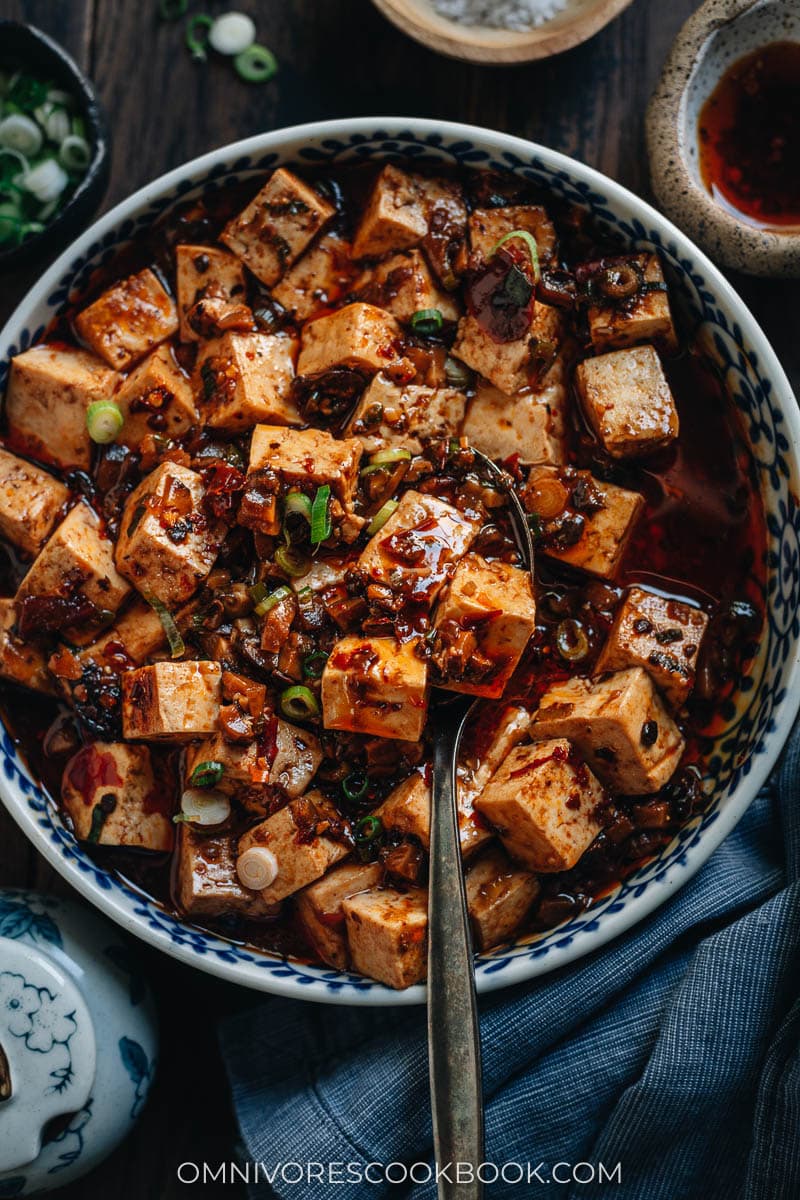
The secret to making the best tasting mapo tofu is to use the freshest Sichuan peppercorns you can find, plus a high quality Chinese Doubanjiang. To make the best vegan mapo tofu, I used dried shiitake mushrooms and their soaking water for an intense umami. I also used homemade fermented black bean sauce instead of soy sauce to give it extra depth of flavor. Soft (or even silken) tofu is often used in China for the best texture. Feel free to replace it with medium or firm tofu if you find soft tofu too hard to handle in a braised dish.
In the past I’ve shared a recipe for authentic Sichuan style mapo tofu, which is rich and flavorful thanks to the added ground meat. But sometimes I just want a lighter dinner with plant-based ingredients. That’s why I developed this vegetarian mapo tofu recipe. The cooking process is quite similar to that of the original mapo tofu, but it’s healthier and still yields a super delicious result.
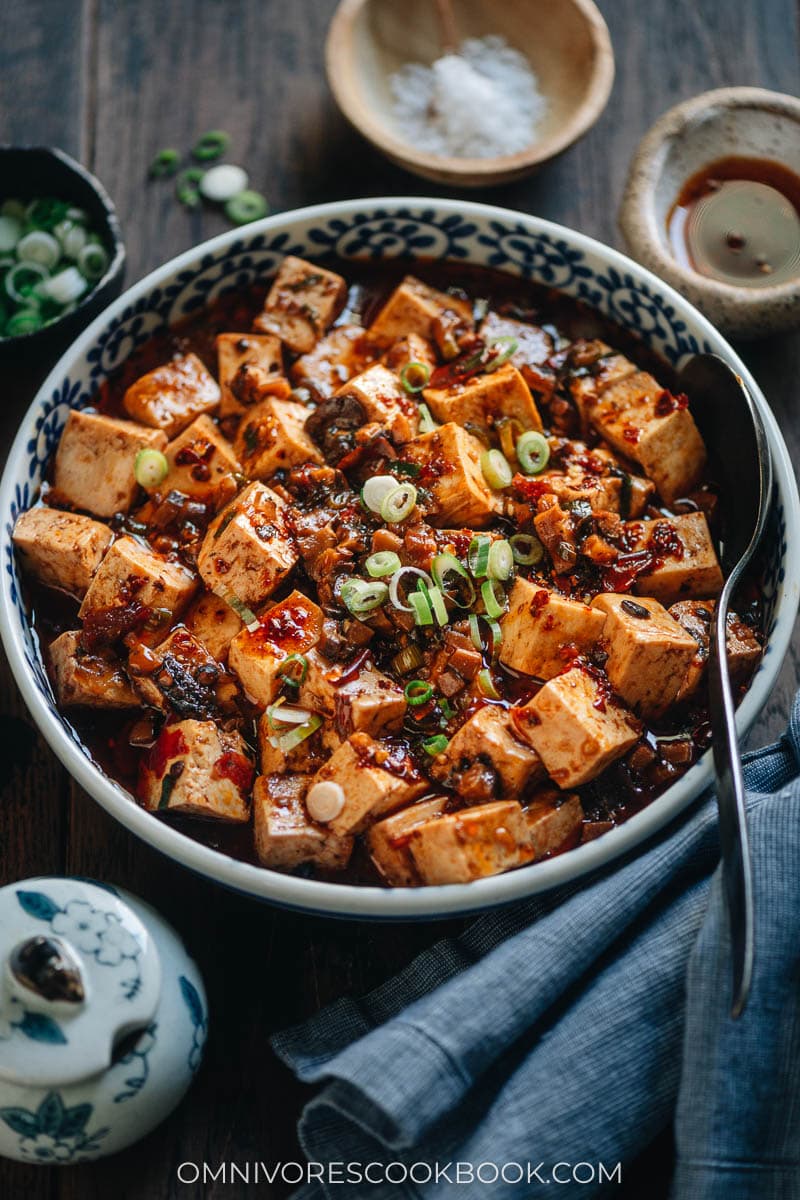
Key Ingredients
Doubanjiang
Doubanjiang (豆瓣酱), also called fermented spicy bean paste, is not your average hot sauce. It is a super rich, fermented, spicy paste made with dried fava beans, fresh chili peppers, salt, and wheat flour, then aged for one to eight years. Doubanjiang has a deep savory, spicy, and quite salty taste. It is a key ingredient in classic Sichuan dishes such as Mapo Tofu, Sichuan Eggplant Stir Fry, Sichuan Beef in Hot Broth, and Sichuan Fish with Pickled Mustard Greens. You can find it in an Asian market, on Amazon, or at Mala Market.
Fermented black bean sauce
Fermented black bean sauce, or Douchijiang (豆豉酱) in Chinese, is a delightfully savory sauce made from douchi (cooked black soybeans fermented in salty water), onion, chili peppers, Shaoxing wine, sugar, garlic, and ginger.
The flavor is like that of soy sauce, but with an even stronger fermented fragrance and much more dimension.
It’s a fantastic multi-purpose sauce, as well as a key ingredient in Twiced Cooked Pork, Steamed Fish with Black Bean Sauce, and Stir Fried Chicken with Black Bean Sauce.
You can either buy it pre-made from the store or make your own. (Making your own is way better! But I understand if you’re pressed for time.)
Once you have these two ingredients, you’re halfway to authentic-tasting vegetarian mapo tofu!
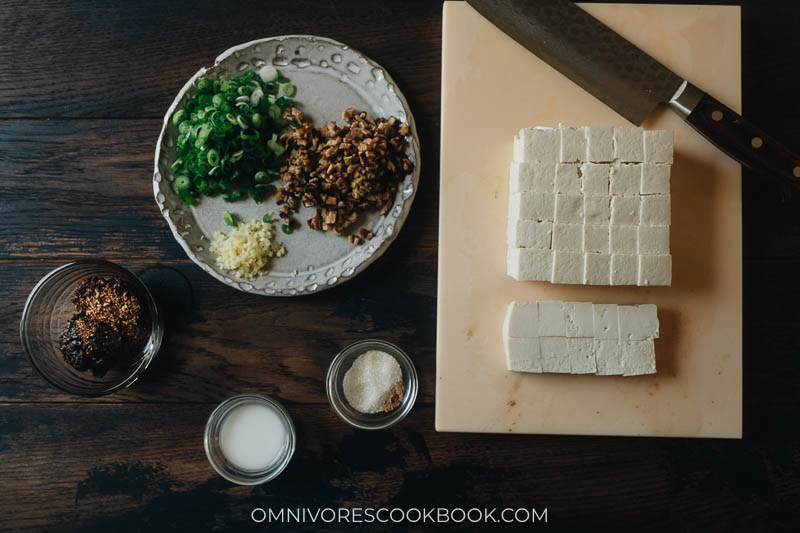
Sichuan peppercorns
Sichuan peppercorn (Hua Jiao, 花椒) is another key ingredient that you might not be familiar with. Fresh Sichuan peppercorns have a pungent aroma that lingers around the nose. Its taste is almost indescribable: numbing, tingling, and somewhat refreshing like mint. These peppercorns add a savory, smoky, and slightly citrusy flavor to a dish, and it’s that flavor that makes genuine Sichuan food. I consider it even more important than Sichuan chili peppers, truly distinguishing the dish and giving it a character unlike anything else. It’s a key ingredient in many classic Sichuan dishes such as Dan Dan Noodles, Mala Chicken, and Red Oil Wontons.
I highly recommend you purchase Sichuan peppercorns from Mala Market. They carry the freshest Sichuan peppercorns in the US, sourced directly from Sichuan. It truly makes a world of difference.
It might seem like a lot of trouble to source three special ingredients to make one dish. But here is the deal. Each ingredient is fermented for months, sometimes years, to achieve its ultimate umami taste. And you can spend a few dollars to get years of essence packed into your dish. Isn’t that amazing? Think about aged balsamic vinegar and parmesan cheese in Italian cooking. They’re totally worth the investment. Plus, you can use these ingredients to create so many great Chinese dishes.
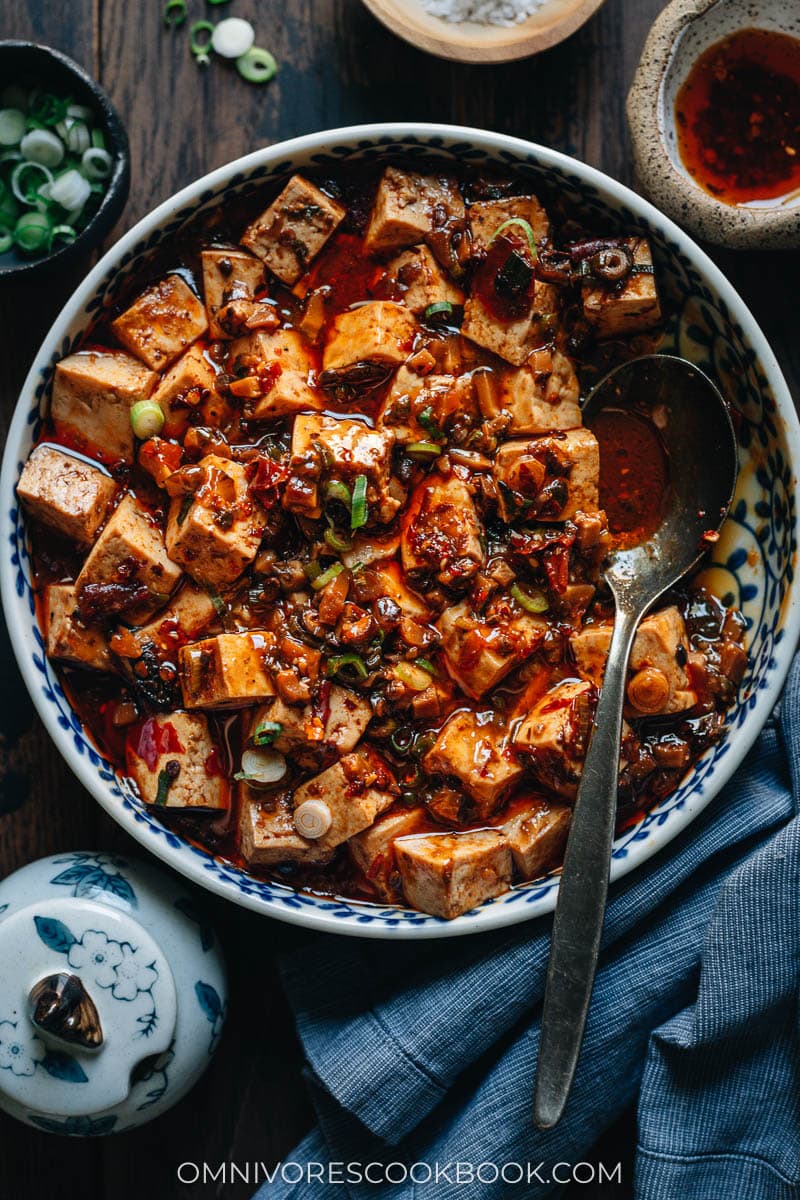
Also Important: Dried Shiitake Mushrooms
While dried shiitake mushrooms aren’t as uncommon as the Sichuan ingredients discussed above, they’re crucial to giving the dish a big, mouth-filling umami.
The traditional version of this dish uses ground pork, and I’m happy to let you know that dried shiitake mushrooms pack just as much savory goodness.
You’ll rehydrate the mushrooms, mince them up, and use the rehydrating water as broth for the sauce. It’s an easy way to get huge flavor, and it works perfectly here.
Cooking notes
One word about oil
Authentic mapo tofu uses quite a lot of oil to create that appetizing red color. For the homemade version, I tend to hold back on the oil to make my dinner healthier. I usually use 2 to 3 tablespoons of oil just so it’s just enough to properly cook the spices. If you are concerned about oil intake, you can reduce the oil to 1 tablespoon. In this case, you might need to splash some water if the spices start to stick to the pan.
How to create a rich sauce
As I mentioned above, the doubanjiang, fermented black beans, and Sichuan peppercorns are the key to creating the best sauce. In addition, I added dried shiitake mushrooms to the dish. They add a bit more nutrition to the meal, and the mushroom juice lends its rich flavor to the sauce.

Need more veggies?
It’s not shown in the pictures here, but sometimes I add a batch of spinach or baby bok choy at the end of the cooking, just to add some greens to my meal. It only takes a few seconds to cook through the veggies and it’s super tasty. It’s extra convenient if you’re cooking for one, to make a very nutritious one-pot meal.
That’s it! I hope you find the recipe easy to follow and the results rewarding!
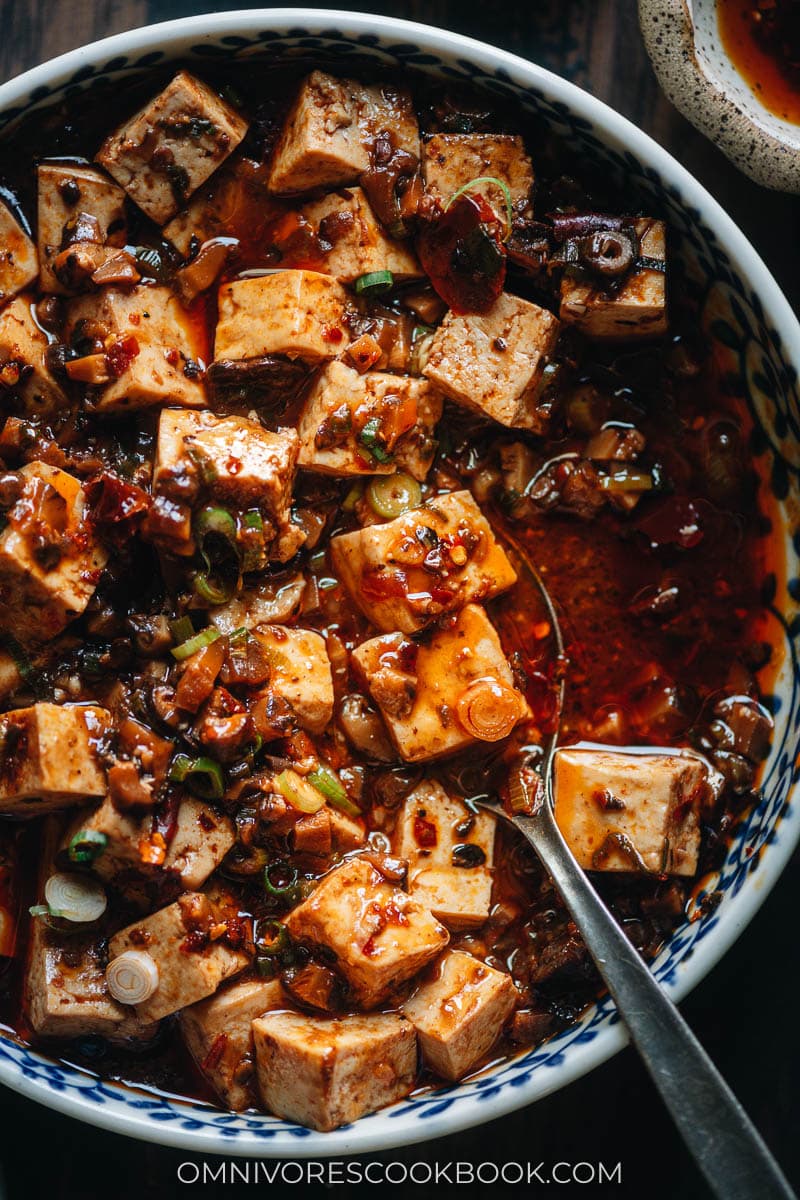
More easy delicious vegetarian recipes
- Chinese Eggplant with Garlic Sauce
- Easy Vegetarian Thai Curry
- Easy Vegetarian Lentil Stew
- Vegetarian Hot and Sour Soup
- Vegetarian Chow Mein
If you give this recipe a try, let us know! Leave a comment, rate it (once you’ve tried it), and take a picture and tag it @omnivorescookbook on Instagram! I’d love to see what you come up with.
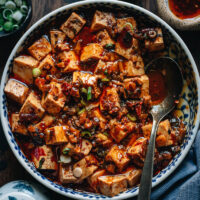
Vegetarian Mapo Tofu
Ingredients
- 4 large dried shiitake mushrooms (or 6 small ones)
Spice mix
- 2 tablespoons Doubanjiang
- 1 tablespoon homemade black bean sauce (or store-bought sauce)
- 1/4 teaspoon freshly coarsely ground Sichuan peppercorns
Cooking
- 2 to 3 tablespoons peanut oil (or vegetable oil)
- 2 green onions , sliced
- 1/2 inch (2.5 cm) ginger , minced
- 2 teaspoons Shaoxing wine
- 1 cup mushroom soaking water
- 1 block (16 ounces / 450 g) soft tofu , cut into ½ inch (1.5 cm) cubes (*Footnote 1)
- 1/8 teaspoon five-spice powder
- 1 teaspoon sugar (or to taste)
Slurry
- 1 teaspoon cornstarch
- 1 tablespoon water
Garnish
- Homemade chili oil (Optional)
Instructions
- Add the dried shiitake mushrooms into a small bowl and add 1 cup hot water to cover. Let soak for 20 minutes, or until the mushrooms turn soft throughout. Squeeze out excess water and rub off any debris from the mushrooms. Finely chop the mushrooms into ¼ inch (1/2 cm) squares. Reserve the soaking water for later use.
- Combine the spice mix ingredients in a small bowl.
- Heat 2 Tablespoons oil in a large nonstick skillet over medium heat until warm. Turn to medium-low heat and add the spice mix. Cook and stir for 1 minutes.
- Add the chopped shiitake mushrooms, green onion, and ginger. Cook and stir until the aromatics are lightly browned and the oil starts to turn an orange red hue. Add more oil if the pan looks too dry.
- Pour in the Shaoxing wine and quickly use your spatula to release any brown bits from the pan.
- Pour in the mushroom soaking water, being careful not to add the debris from the bottom of the bowl.
- Add five spice powder and sugar. Mix a few times to dissolve.
- Carefully spread the tofu in the broth in a single layer. Turn to medium-high heat and bring to a simmer. Turn to medium-low heat again and simmer for 5 minutes.
- Meanwhile, make the slurry by whisking cornstarch with water in a small bowl until completely dissolved. Swirl half of the mixture into the tofu, stirring gently with a spatula. Add more until the sauce reaches the desired consistency. Taste a piece of tofu with some sauce. Add more sugar to balance the taste if it is too spicy for you. Transfer everything to a big plate.
- (Optional) If you want your dish to look like the authentic mapo tofu in Sichuan, swirl in a few tablespoons of homemade chili oil at the end of the cooking, to give the sauce a beautiful red color. It won’t affect the taste if you skip this step.
- Serve over steamed rice as a main.
Notes
- Soft tofu is a bit tricky to handle but it creates the proper restaurant-style texture. You can totally replace it with firm or medium tofu and still get a great result.
Nutrition
The recipe was updated with major changes in 2021. If you want the older version, see the recipe below.
Vegetarian mapo tofu (old version)
INGREDIENTS
Spice mix
- 2 tablespoons fermented black beans
- 2 tablespoons Doubanjiang (spicy fermented bean paste)
- 1 teaspoon Chinese chili flakes
- 1/4 teaspoon ground Sichuan peppercorns
Cooking
- 2 to 3 tablespoons peanut oil (or vegetable oil)
- 2 green onions, chopped
- 1 tablespoon minced ginger
- 2 cloves garlic, minced
- 2 cups vegetable stock
- 1 (450-g / 16-oz) block medium-firm or firm tofu, cut into 1/2-inch (1.5-cm) cubes
- 1/2 lb (225 g) mushrooms, sliced
- 1/8 teaspoon five-spice powder
- 1 teaspoon sugar or to taste
- 1 tablespoon cornstarch
- (Optional) Homemade chili oil, for garnish
INSTRUCTIONS
- Add fermented black beans to a small bowl. Add water to cover, gently rub a few times with your fingers, and drain well. Use the back of a small spoon to smash the beans into smaller bits. Add the doubanjiang, chili flakes, and Sichuan peppercorns to the same bowl.
- Heat 2 tablespoons oil in a large skillet over medium heat until warm. Add green onion, ginger, and garlic. Stir a few times to release the fragrance.
- Add the spice mix from step 1. Cook and stir for 1 to 2 minutes, until the paste is cooked through and very fragrant. If the paste starts to stick to the pan, add a bit more oil or some vegetable broth and use your spatula to release any stuck bits.
- Add the mushrooms. Cook and stir for 2 minutes or so, until the mushrooms are evenly coated with the spices. Add a bit of vegetable broth if it start to stick.
- Add the vegetable stock, five spice powder, and sugar. Stir to mix well and bring to a simmer.
- Spread the tofu in the broth in a single layer. Turn to low heat and simmer for 10 to 15 minutes or so.
- Whisk cornstarch with 3 tablespoons water until completely dissolved. Swirl half of the mixture into the tofu, stirring gently with a spatula. Add more until the sauce reaches the desired consistency. Taste a piece of tofu with some sauce. Add more sugar to balance the taste if it is too spicy for you. Transfer everything to a big plate.
- (Optional) If you want your dish to look like the authentic mapo tofu in Sichuan, swirl in a few tablespoons of homemade chili oil at the end of the cooking, to give the sauce a beautiful red color.
- Serve over steamed rice as a main.














That looks so good! We have an amazing Chinese restaurant near us and they are from Chengdu. They make a wonderful Mapo Tofu but they do use a metric ton of oil. A lighter version sounds great. I look forward to trying this.
I am in love with all the great flavors here. I love both the spicy bean paste and fermented black beans. I keep them along with my shrimp paste, kimchi and all the other goodies in my fridge. That stuff just has so much flavor. Great tip on the szechuan peppercorns – I’ll have to check that place out.
I got a large jug of anchovy sauce (kknari) from a Korean market but do not know what recipes it is used for. Do you?
Would dried shiitake mushrooms be an acceptable substitute for fresh mushrooms in this recipe?
I have just made it for dinner and it is delicious! Better than any I have eaten in restaurants which are always too oily and too garlicky. The only thing I changed was, I cooked the onion, ginger and garlic in water instead of oil. I wanted to check if it changes the taste at all, the change is so minor that I can totally do without the oil. Instead of chilli oil I also just used dried chilli flakes. Its quite salty so I have not seasoned the rice or the wilted spinach and courgettes, which balances out the saltiness. Thank you for another great recipe…
Hi Maggie, I made this recipe a few weeks ago after getting my hands on some bean paste and Doubanjiang at a local Chinese grocery store. Wow! I was totally blown away by the flavors in the dish and my husband was equally impressed. I had not guessed how complex the preparation of these ingredients is. It made my cooking relatively easy for an incredible dish. I’m making a variant of this tonight and excited to try it. Your website is now my go to for Chinese cooking!
This recipe looks absolutely delicious! Ican’t wait to try this. I don’t have any fermented black beans on hand. Have you tried leaving them out or do you think the recipe would work without them?
Hi Sabine, yes you can leave out the fermented black beans. It is similar to soy sauce with a different note, but you can cook the dish without it.
Fantastic veggie Mapo tofu. We’re totally addicted and have made it over 10 times now for many, many friends. It’s mind blowing.
Recipe was nice but I prefer the original veg.mapo tofu, which you seem to have taken down,can you put the old recipe back up.
Thanks.
Really tasty – def be making again and again – though I did add some Chinese cabbage to add some crunch. Might use semi-firm tofu next time as the soft tofu just broke up.
Absolutely loved this recipe! So tasty and easy to make. The only thing was that there wasn’t much sauce at the end so I’d probably add a bit more spice mix + water next time.
Maggie–I first made a batch of your wonderful Salt & Pepper Tofu, only skipping the spice mixture at the end. Then I added that crispy tofu to the Vegetarian Mapo Tofu–and only let it boil for a short time. Ta-da–slightly crispy and umami-like tofu cubes that have a meat-like texture, complete with a tender skin. Thanks for the inspiration. I adore your blog!
The old version is far superior and packs much more of a punch.
Wow! This was my first time making mapo tofu and I was surprised by how simple it was. It tasted SO close to what I’ve had in restaurants—and I was missing the black bean sauce, so I suspect that would have gotten it there. Thank you for this recipe! I will definitely be making it again.
This was excellent. I made it exactly according to the recipe.
I used your recipe to save a not-so-good carry-out Mapo Tofu I got from a restaurant the other day. It did the trick! I won’t bother with getting it to go anymore, if I can make it this good at home. Thank you!
Really benefited from adding peanuts; broke up the soft texture monopoly of the dish and gave it a great earthy counter note. We also subbed mushrooms (neither of us like those) for roasted seaweed; gave a decent umami. Otherwise very solid recipe!
Made this with the egg fried rice recipe from this site, combination was absolutely amazing!